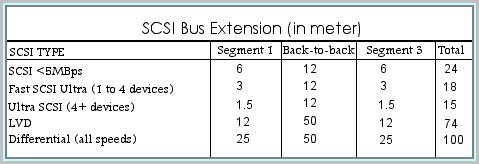| |||||||||||||||||||||||||||||||
|
Extending the SCSI Bus with Expanders As companies and IT departments continue to grow and as system administrators add devices with varying SCSI technologies to legacy bus domains, the cable-length limitations of standard SCSI can pose problems. All copper cable causes timing delays of approximately 1.5ns per foot. When SCSI-specified cable length is exceeded, this delay will normally cause a system to malfunction. This can present serious problems when business expansion or other developments mandate that users and storage devices cannot be located close to one another. Fortunately, it's possible to inexpensively extend SCSI cable lengths without completely changing your system. SCSI has three defined data transmission modes: Single-Ended (SE), High Voltage Differential (HVD), and multimode Low Voltage Differential (LVD/MSE). The transmission mode of a storage system largely dictates its transmission speed as well as the maximum cable length. In the early days, it was assumed that SCSI bus lengths could not be expanded beyond a few meters. This assumption was tied to the fact that devices on a SCSI bus must send and receive transmissions (from the initiator to the target device and back again) within a very small time frame. If too much time passed between transmissions, a device would "think" that the transmissions have ended and would essentially shut down. Since a longer cable would necessarily mean longer time between transmissions, expanding the SCSI bus length would, at some point, make it impossible to maintain continuous transmissions between devices. Given the existing transmission speeds at the time, it was therefore concluded that the limits on maximum cable length (i.e., no more than a few meters) were set in stone.  Since then, SCSI bus expanders were developed to "outsmart" the SCSI devices and maintain the transmission flow. An expander acts as a bridge, receiving data from the initiator and passing it on to the target. The target thinks it is transmitting data directly to the initiator and vice versa. Subsequently, second-generation fiber-optic versions of these expanders provided the ability to extend the SCSI bus up to 760m. This type of expander is suited for systems that employ lower-speed devices such as digital cameras, data acquisition systems, and backup storage systems, which do not require extremely fast transmission speeds. Segmenting the Bus Think of the SCSI bus as being composed of a number of segments. By electrically isolating two segments from one another, SCSI expanders enable you to isolate faster devices from slower devices and extend the bus length at the same time. Assume you have a SCSI domain with three LVD SCSI devices and two slower SE Ultra SCSI devices. Without expanders, this segment with more than four devices on it could only be 1.5m long, with Ultra SCSI as the maximum data throughput. However, once the LVD SCSI devices are isolated from the slower SE Ultra SCSI devices via an expander, the LVD SCSI segment with three devices could be 12m long, and the slower SE SCSI segment could be 3m long. The LVD devices would communicate at LVD speeds, and the SE devices would communicate at Ultra SCSI throughput rates. SCSI Converters Suppose a device employing LVD transmission mode is placed on an existing SCSI bus that employs HVD transmission mode. In order for the new device to interact with the existing bus, it is necessary to use an LVD-to-HVD converter. From an operational standpoint, the converter is transparent to the devices on either side. From a bus-length standpoint, the converter works as an extender. The converter creates a SCSI bus domain with two segments: LVD and HVD. Each segment can be up to 25m long, regardless of the transmission speed. Expanders also can be used to extend SCSI systems that employ the same transmission mode (SE, LVD, or HVD) throughout the bus. For instance, by connecting two HVD expanders in a back-to-back configuration (i.e., with no other SCSI device between them), the total HVD cable length can be up to 100m long. The back-to-back expander method of SCSI extension reaches its practical limit in the 60m to 100m range. The solution to extending the bus beyond this point is to use fiber-optic or coaxial copper cable and a pair of SCSI devices that communicate with each other through a proprietary serial protocol. These units, known as serial expanders, are available for lengths ranging from 100m over coaxial cable to more than 40km using fiber optics. Additionally, another type of expander can be used to connect two bus segments in a single SCSI domain and thereby increase the overall cable length. These devices adjust the signal timing and effectively regenerate the signals they receive. This enables them to isolate two bus segments electrically, so that a malfunctioning device on one segment will not affect the operation of the devices on the other segment. Also, since the two bus segments are isolated from one another, the electrical limitations such as bus length only apply to each segment independently, rather than applying to the bus as a whole. When two of these expanders are connected back-to-back, the SCSI cable between them can be up to twice the normal cable length, thereby extending the bus by a factor of four to 10, depending on the type of SCSI used. For More Information Contact: InforStor Magazine, Web Site--http://is.pennnet.com Data storage source for information including fiber channel, storage area networks, network attached storage and RAID. Also covers tape/optical drives, security, juke boxes, and warehousing. A PennWell Corporation. Marc D. Brooks is an active member of the STA and founder and CEO of Paralan Corporation, a manufacturer of SCSI bus enhancement products (Expanders) | |||||||||||||||||||||||||||||||
|
Paralan Corporation 4655 Ruffner Street, San Diego, CA 92111 Sales: (800) 479-7719 | Tel.: (858) 560-7266 | Fax: (858) 560-8929 | E-mail: info@paralan.com |
|||||||||||||||||||||||||||||||

Custom Search
|


